The future is Link: A look inside Sound Transit's new light rail system
As the cost of driving continues to rise thanks to soaring gasoline and diesel prices, Puget Sound commuters are increasingly clamoring for alternatives to the automobile to get around. Transit ridership is climbing, and Sound Transit is working diligently to increase service to meet demand.
The agency recently opened a new Sounder station in Mukilteo (Tim Eyman's hometown) and is asking the public for feedback on a possible ballot proposal which would increase revenue to fund more rapid transit across the region.
With the exception of Sounder and streetcars like the South Lake Union Trolley or Tacoma Link, the region's transit network is comprised of buses operated by King County Metro, Community Transit, Pierce Transit, and Everett Transit. And unfortunately, the skyrocketing cost of fuel is making it more expensive to run the bus fleet, as the Wall Street Journal reported on May 30th:
The combination of rising fuel prices and slumping sales tax revenue (due to a slackening in consumer spending) is putting the squeeze on public transit providers across the country. With buses becoming more expensive to operate, it is absolutely imperative that our region construct a rail backbone that can transport commuters effectively, quickly, and reliably through our most congested corridors.
Our economy depends on our common wealth, including our transportation system. And beginning next year, our transportation system will get a big boost with the opening of Central Link, the region's first light rail line.
Because Link runs on electricity, and not diesel, it is both clean and inexpensive to operate. In terms of efficiency, it's also vastly superior to buses.
Sound Transit broke ground on Central Link five years ago. Today, the system is nearly complete and most of the project's components have been delivered on time by contractors. The Downtown Transit Tunnel has been renovated, much of the track has been laid, and many of the stations are complete. The Emerald Mole has drilled the Beacon Hill Tunnel, an astonishing engineering feat.
Several days ago, Sound Transit graciously offered the Northwest Progressive Institute a tour of the new Central Link system, including the new Operations & Maintenance facility in south Seattle, the almost finished Tukwila station, and much of the actual route, which connects Seattle to SeaTac International Airport.
What follows is a look inside Central Link, with accompanying information about what riders can expect when the line opens to the public in 2009.
All of the photos you're about to see, by the way, exist because of you, our readers, and other supporters like you, who generously donated money to help us expand our work. Thanks to your financial support, the Northwest Progressive Institute been able to invest in new state-of-the-art media equipment that allows us to tell a story not just through text, but rich multimedia... images, audio, and video.
So enjoy the pictures! Your investment made them possible.
The vehicles
The Link fleet totals thirty five vehicles, all manufactured by Kinkisharyo of Japan. The frames and shells are built in Osaka and sent to the Pacific Northwest for final assembly. The rail cars are 3.81 meters in height, and 2.65 meters in width. The first delivery was made just over a year and a half ago, in November of 2006.
Sound Transit has been conducting continuous testing of the vehicles to prepare the fleet for service next year. If you've traveled through south downtown in recent months, you've probably seen Link vehicles out on the tracks at some point.
When we arrived at the Operations & Maintenance facility in the rain last week, several vehicles were out in the yard undergoing testing.
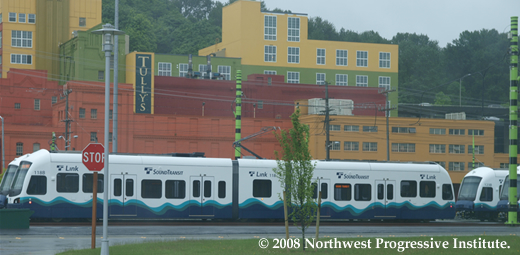
More were inside the garage, where they can be inspected underneath from maintenance pits or serviced from above via elevated platforms.
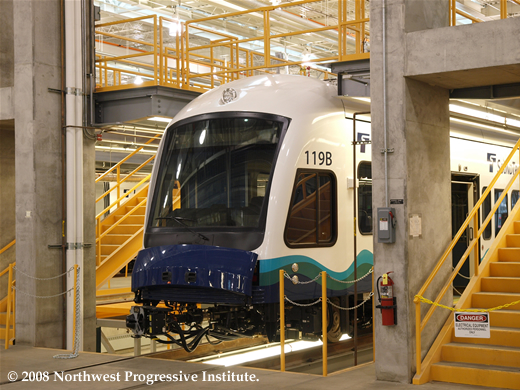
The shot above shows the front of one of the vehicles, with the panel raised to allow technicians access to the machinery underneath. To the sides are stairwells leading up to the raised platforms next to the train. This next shot (below) shows the top of the vehicle, plugged in for systems testing.
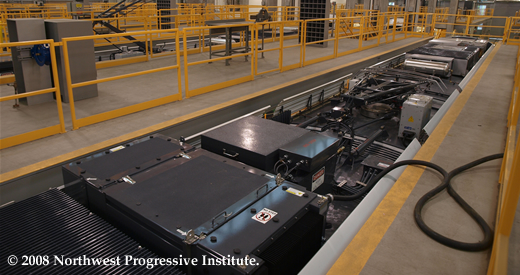
Now, let's take a look at the maintenance pit, which is mostly used for inspections (not service work), according to the operations team.
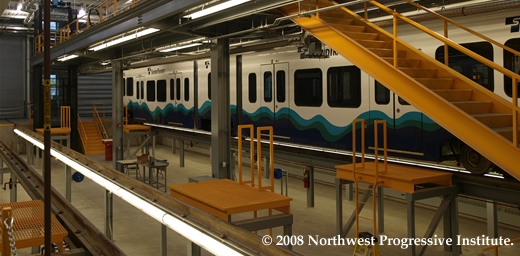
Here's a closeup shot of what the vehicle looks like from underneath.
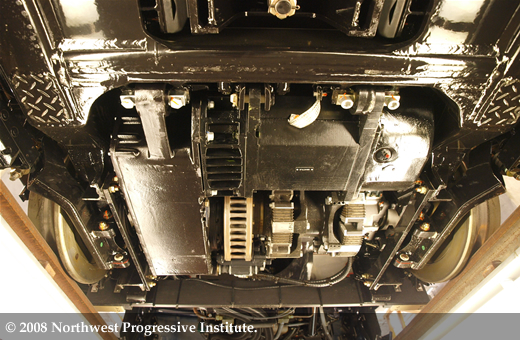
And here's a view of the wheels.
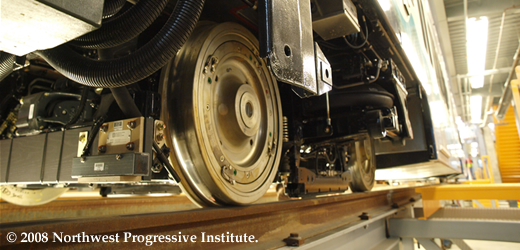
Now, let's actually head on inside the train. What you're about to see is the finished interior of the Link vehicles.
While exterior shots may be found everywhere (in Sound Transit's slideshows, television ads seeking public input, on the local five o'clock news, and in newspaper stories) views of the inside are uncommon.
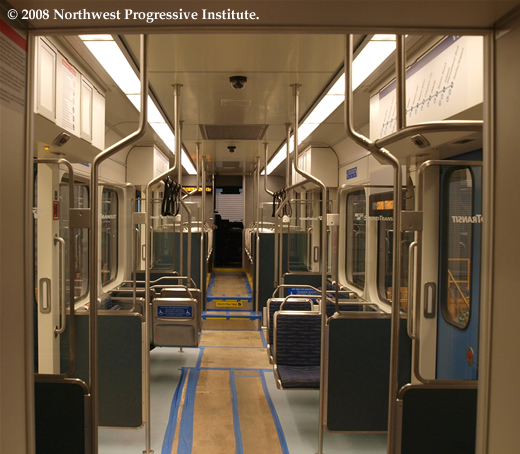
My first impression, once I stepped inside, was a memory of my experience in Chicago last summer. I stepped off my flight at Midway International Airport and boarded an Orange Line train to downtown and my hotel.
I was delighted by how reliable, simple, and efficient the train was there. I'm pleased to report that Link will be every bit as comfortable and navigable. Sound Transit has thought of everything.
For example, route maps above the doors:

...and scrolling LED screens that can display the time, the next station stop, and other important information for riders:

Sound Transit tells NPI that the Link system will include clear audio cues, not unlike the ones that are used on Sounder today. These cues were hugely beneficial to me in Chicago, and they're essential for riders who are blind. They provide orientation so riders know where they are. For example, the voice might say:
Doors closing.
This is a southbound train to SeaTac International Airport. Estimated arrival is twenty two minutes.
The next stop is the International District/Chinatown Station. Transfer to Sounder, ST Express, Metro, and Amtrak.
In Chicago, the entire transit system - including the bus fleet - uses the same consistent cues, making it much easier to ride.
Here's another view of the interior:
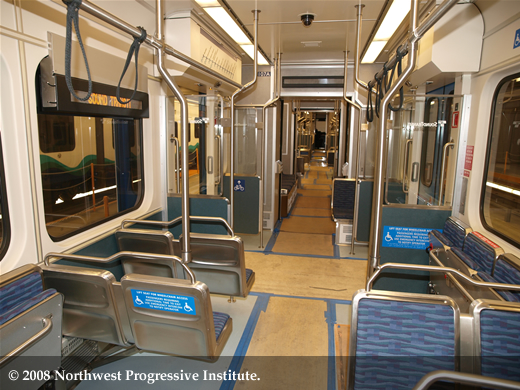
The cardboard taped down to to the floor is there to protect the new vehicle walkways from getting dirty and marked up before they enter service.
Link cars utilize low floors and have plenty of room on board for disabled riders. There's even space for two bicycles to be stored. The trains are designed to be very comfortable, with climate control and air conditioning. Link trains can be configured with one, two, three, or four cars, making the system highly flexible.
Finally, let's take a look inside the driver cab:
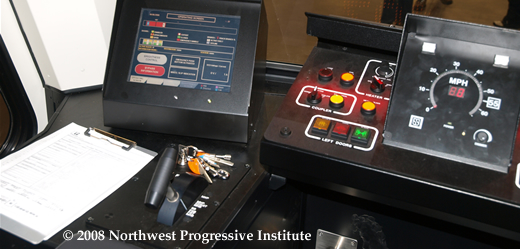
Link cars are equipped with advanced controls that help operators keep passengers, pedestrians, and motorists safe.
Video monitors on either side of the cab help eliminate blind spots. A multi-volume horn allows an audio warning to be sounded if necessary.
The main display shows the speed, status of the vehicle (for example, whether doors are open or closed) and information about the brakes. The train is smart enough to enforce vehicle braking when required without operator intervention.
Central Link trains will reach a top speed of 55 miles per hour (or 88 kilometers per hour) but won't travel at that speed wherever the track is at grade and next to a roadway, housing, or businesses (such as along Martin Luther King Jr. Way).
Tukwila station
Sound Transit's Tukwila International Boulevard Station is easily one of the largest on the Central Link route. It's the only station with parking and the second to last stop on the southbound end of the line.
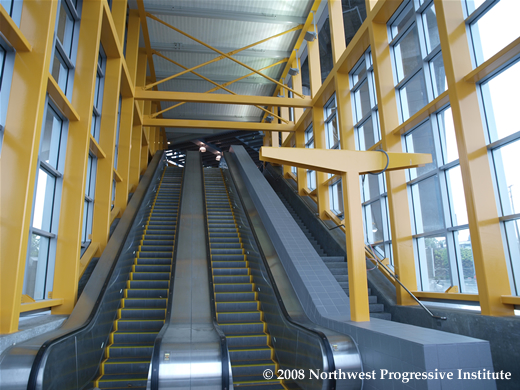
It was explicitly designed to facilitate easy transfers to buses. The bus turnaround is actually under the station platform, which was built alongside the aerial track above ground. The grand entrance to the station, seen above, leads upstairs to the main level, which is covered and features hanging public art.
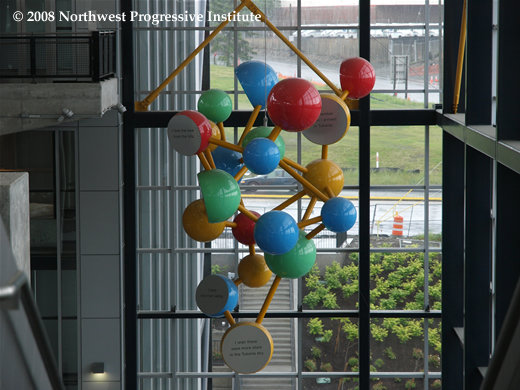
The station will look quite a bit brighter and cheerier on sunny days thanks to all the windows, but unfortunately, there was a downpour the day of the tour, so the skies are a cloudy, misty gray outside in these photos.
Another flight of stairs, escalators, and several elevators lead to the station platform at the top. There is ample space for passengers to wait to board either a southbound train to SeaTac or a northbound train to Westlake Center, most of it covered (although not entirely sheltered from the elements).
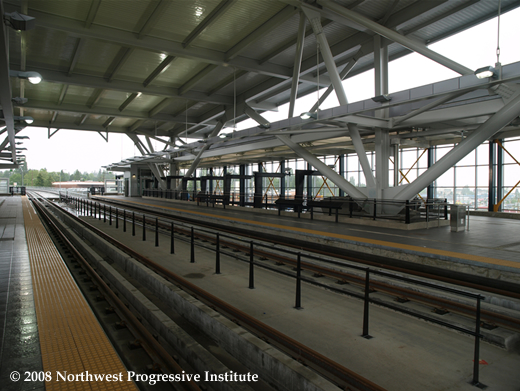
To the north, the track features a crossover - a pair of switches that allow trains to be moved over from one track to the other.
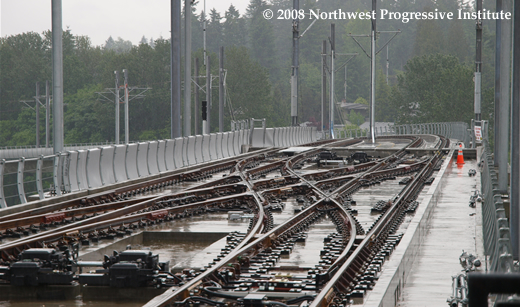
The future is Link
As of the end of last month, there is continuous track running all the way from Westlake Center in downtown Seattle to SeaTac International Airport. Before the end of summer, Central Link test runs will be extended along the line all the way to Tukwila (currently, testing is happening in South Downtown only).
With construction on Link ninety percent complete, the future of rapid transit in our region is just over the horizon. More importantly, Sound Transit is the only public agency planning and building a transportation system that doesn't rely solely on the internal combustion engine. Link means greater energy independence and new options for commuters. The right wing has bitterly fought Central Link every step of the way, but they have lost. Rapid transit is coming to the greater Seattle area.
At a time when fuel prices are in flux (but generally rising) we need all the efficient, safe, and speedy electric light rail we can get.
The agency recently opened a new Sounder station in Mukilteo (Tim Eyman's hometown) and is asking the public for feedback on a possible ballot proposal which would increase revenue to fund more rapid transit across the region.
With the exception of Sounder and streetcars like the South Lake Union Trolley or Tacoma Link, the region's transit network is comprised of buses operated by King County Metro, Community Transit, Pierce Transit, and Everett Transit. And unfortunately, the skyrocketing cost of fuel is making it more expensive to run the bus fleet, as the Wall Street Journal reported on May 30th:
[A]t the very moment they should be investing to expand their services, the same driver that is ballooning ridership is crippling transit budgets: steep fuel bills.This is one of the problems with heavy reliance on "rubber tire transit" (a term that John Carlson is fond of): Buses and shuttles, like cars, need fuel to power their internal combustion engines. Lots of fuel.
As record numbers of people board buses and trains, higher costs are forcing public transit agencies to scale back on services, further straining capacity. Local transit agencies fret that the capacity problems may squander the opportunity to convert more Americans to public transportation.
"There's only so many times a person can walk out to a bus stop and say, 'Oh, it's too crowded to ride, I'm driving,'" says Jeff A. Meilbeck, general manager of the Northern Arizona Intergovernmental Public Transportation Authority. Ridership on Flagstaff's Mountain Line rose 34% to 85,602 in April from 63,685 in April 2007, he says, noting that drivers have had to turn some riders away.
The combination of rising fuel prices and slumping sales tax revenue (due to a slackening in consumer spending) is putting the squeeze on public transit providers across the country. With buses becoming more expensive to operate, it is absolutely imperative that our region construct a rail backbone that can transport commuters effectively, quickly, and reliably through our most congested corridors.
Our economy depends on our common wealth, including our transportation system. And beginning next year, our transportation system will get a big boost with the opening of Central Link, the region's first light rail line.
Because Link runs on electricity, and not diesel, it is both clean and inexpensive to operate. In terms of efficiency, it's also vastly superior to buses.
Sound Transit broke ground on Central Link five years ago. Today, the system is nearly complete and most of the project's components have been delivered on time by contractors. The Downtown Transit Tunnel has been renovated, much of the track has been laid, and many of the stations are complete. The Emerald Mole has drilled the Beacon Hill Tunnel, an astonishing engineering feat.
Several days ago, Sound Transit graciously offered the Northwest Progressive Institute a tour of the new Central Link system, including the new Operations & Maintenance facility in south Seattle, the almost finished Tukwila station, and much of the actual route, which connects Seattle to SeaTac International Airport.
What follows is a look inside Central Link, with accompanying information about what riders can expect when the line opens to the public in 2009.
All of the photos you're about to see, by the way, exist because of you, our readers, and other supporters like you, who generously donated money to help us expand our work. Thanks to your financial support, the Northwest Progressive Institute been able to invest in new state-of-the-art media equipment that allows us to tell a story not just through text, but rich multimedia... images, audio, and video.
So enjoy the pictures! Your investment made them possible.
The vehicles
The Link fleet totals thirty five vehicles, all manufactured by Kinkisharyo of Japan. The frames and shells are built in Osaka and sent to the Pacific Northwest for final assembly. The rail cars are 3.81 meters in height, and 2.65 meters in width. The first delivery was made just over a year and a half ago, in November of 2006.
Sound Transit has been conducting continuous testing of the vehicles to prepare the fleet for service next year. If you've traveled through south downtown in recent months, you've probably seen Link vehicles out on the tracks at some point.
When we arrived at the Operations & Maintenance facility in the rain last week, several vehicles were out in the yard undergoing testing.

More were inside the garage, where they can be inspected underneath from maintenance pits or serviced from above via elevated platforms.

The shot above shows the front of one of the vehicles, with the panel raised to allow technicians access to the machinery underneath. To the sides are stairwells leading up to the raised platforms next to the train. This next shot (below) shows the top of the vehicle, plugged in for systems testing.

Now, let's take a look at the maintenance pit, which is mostly used for inspections (not service work), according to the operations team.

Here's a closeup shot of what the vehicle looks like from underneath.

And here's a view of the wheels.

Now, let's actually head on inside the train. What you're about to see is the finished interior of the Link vehicles.
While exterior shots may be found everywhere (in Sound Transit's slideshows, television ads seeking public input, on the local five o'clock news, and in newspaper stories) views of the inside are uncommon.

My first impression, once I stepped inside, was a memory of my experience in Chicago last summer. I stepped off my flight at Midway International Airport and boarded an Orange Line train to downtown and my hotel.
I was delighted by how reliable, simple, and efficient the train was there. I'm pleased to report that Link will be every bit as comfortable and navigable. Sound Transit has thought of everything.
For example, route maps above the doors:

...and scrolling LED screens that can display the time, the next station stop, and other important information for riders:

Sound Transit tells NPI that the Link system will include clear audio cues, not unlike the ones that are used on Sounder today. These cues were hugely beneficial to me in Chicago, and they're essential for riders who are blind. They provide orientation so riders know where they are. For example, the voice might say:
Doors closing.
This is a southbound train to SeaTac International Airport. Estimated arrival is twenty two minutes.
The next stop is the International District/Chinatown Station. Transfer to Sounder, ST Express, Metro, and Amtrak.
In Chicago, the entire transit system - including the bus fleet - uses the same consistent cues, making it much easier to ride.
Here's another view of the interior:

The cardboard taped down to to the floor is there to protect the new vehicle walkways from getting dirty and marked up before they enter service.
Link cars utilize low floors and have plenty of room on board for disabled riders. There's even space for two bicycles to be stored. The trains are designed to be very comfortable, with climate control and air conditioning. Link trains can be configured with one, two, three, or four cars, making the system highly flexible.
Finally, let's take a look inside the driver cab:

Link cars are equipped with advanced controls that help operators keep passengers, pedestrians, and motorists safe.
Video monitors on either side of the cab help eliminate blind spots. A multi-volume horn allows an audio warning to be sounded if necessary.
The main display shows the speed, status of the vehicle (for example, whether doors are open or closed) and information about the brakes. The train is smart enough to enforce vehicle braking when required without operator intervention.
Central Link trains will reach a top speed of 55 miles per hour (or 88 kilometers per hour) but won't travel at that speed wherever the track is at grade and next to a roadway, housing, or businesses (such as along Martin Luther King Jr. Way).
Tukwila station
Sound Transit's Tukwila International Boulevard Station is easily one of the largest on the Central Link route. It's the only station with parking and the second to last stop on the southbound end of the line.

It was explicitly designed to facilitate easy transfers to buses. The bus turnaround is actually under the station platform, which was built alongside the aerial track above ground. The grand entrance to the station, seen above, leads upstairs to the main level, which is covered and features hanging public art.

The station will look quite a bit brighter and cheerier on sunny days thanks to all the windows, but unfortunately, there was a downpour the day of the tour, so the skies are a cloudy, misty gray outside in these photos.
Another flight of stairs, escalators, and several elevators lead to the station platform at the top. There is ample space for passengers to wait to board either a southbound train to SeaTac or a northbound train to Westlake Center, most of it covered (although not entirely sheltered from the elements).

To the north, the track features a crossover - a pair of switches that allow trains to be moved over from one track to the other.

The future is Link
As of the end of last month, there is continuous track running all the way from Westlake Center in downtown Seattle to SeaTac International Airport. Before the end of summer, Central Link test runs will be extended along the line all the way to Tukwila (currently, testing is happening in South Downtown only).
With construction on Link ninety percent complete, the future of rapid transit in our region is just over the horizon. More importantly, Sound Transit is the only public agency planning and building a transportation system that doesn't rely solely on the internal combustion engine. Link means greater energy independence and new options for commuters. The right wing has bitterly fought Central Link every step of the way, but they have lost. Rapid transit is coming to the greater Seattle area.
At a time when fuel prices are in flux (but generally rising) we need all the efficient, safe, and speedy electric light rail we can get.



Comments:
Very fine, clear photographs! Thank you.
King County Metro is under contract to maintain and operate Link Light Rail, within the same organization that operates the Seattle Streetcar.
In the SODO Maintenance Base, how many people did you see at work? Is Metro ramping up staff? I was surprised not to see any workers in the photos, but was it a work day when you toured?
Post a Comment